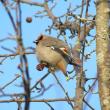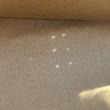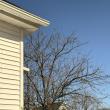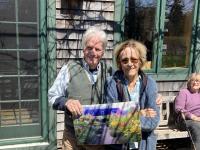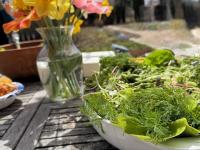What Grizzly Bear Birds and the Eclipse Tell Us about Our Place in the Universe
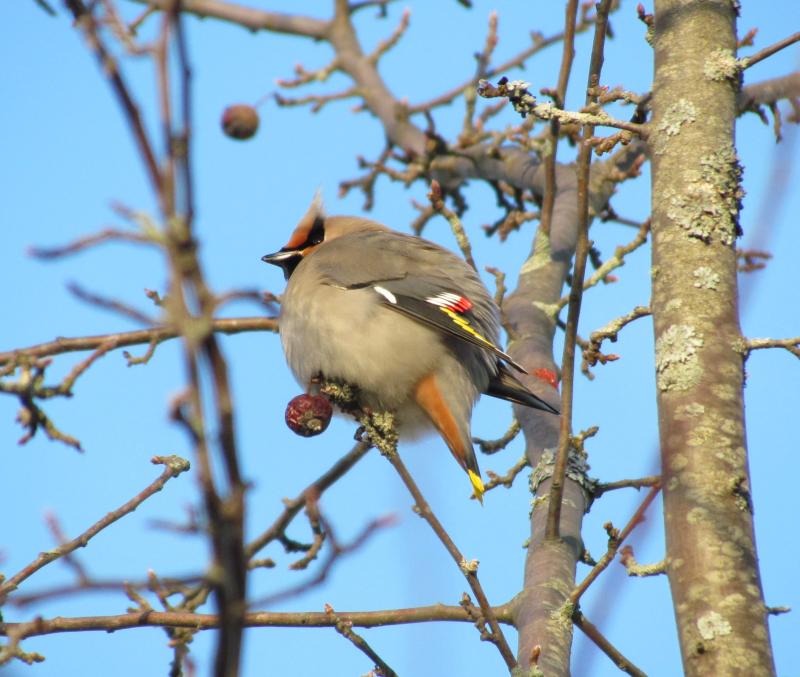 The bohemian waxwing (a.k.a, the “grizzly bear bird”) is an unpredictable winter visitor to Maine that the authors will forever associate with the solar eclipse. Courtesy of Jeff Wells
The bohemian waxwing (a.k.a, the “grizzly bear bird”) is an unpredictable winter visitor to Maine that the authors will forever associate with the solar eclipse. Courtesy of Jeff Wells
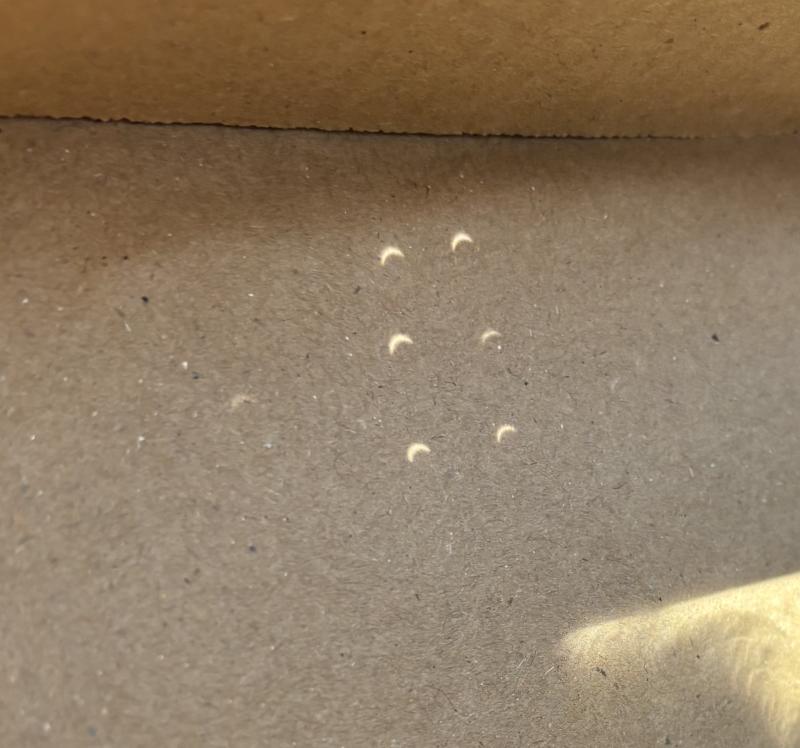 The solar eclipse as viewed safely by the authors using a 6-pinhole contraption, showing the moon beginning to block the sun. Courtesy of Allison Wells
The solar eclipse as viewed safely by the authors using a 6-pinhole contraption, showing the moon beginning to block the sun. Courtesy of Allison Wells
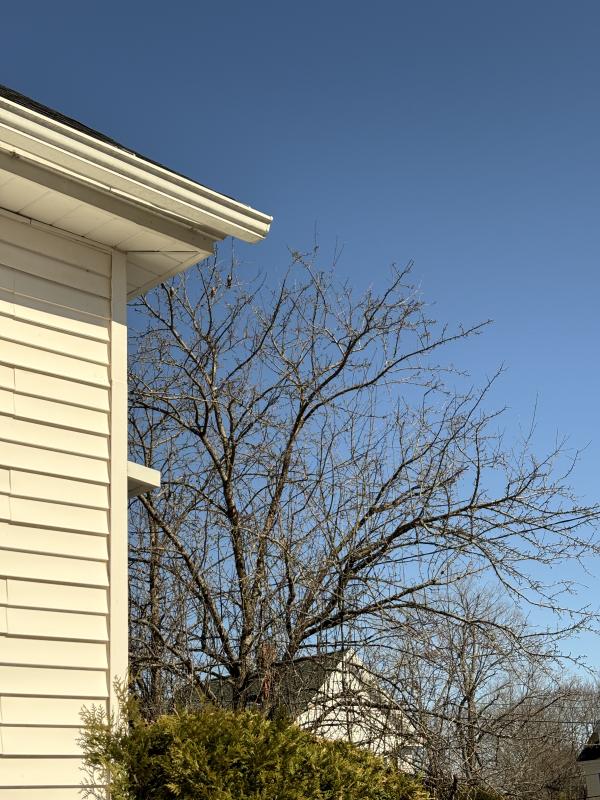 Just as the solar eclipse was reaching its peak, a small flock of bohemian waxwings landed in the authors’ crab apple tree, silhouetted against the dimming blue sky. Courtesy of Allison Wells
Just as the solar eclipse was reaching its peak, a small flock of bohemian waxwings landed in the authors’ crab apple tree, silhouetted against the dimming blue sky. Courtesy of Allison Wells
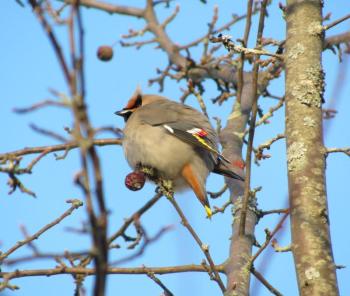 The bohemian waxwing (a.k.a, the “grizzly bear bird”) is an unpredictable winter visitor to Maine that the authors will forever associate with the solar eclipse. Courtesy of Jeff Wells
The bohemian waxwing (a.k.a, the “grizzly bear bird”) is an unpredictable winter visitor to Maine that the authors will forever associate with the solar eclipse. Courtesy of Jeff Wells
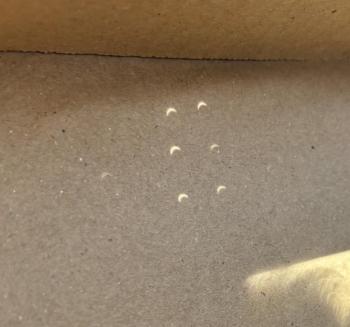 The solar eclipse as viewed safely by the authors using a 6-pinhole contraption, showing the moon beginning to block the sun. Courtesy of Allison Wells
The solar eclipse as viewed safely by the authors using a 6-pinhole contraption, showing the moon beginning to block the sun. Courtesy of Allison Wells
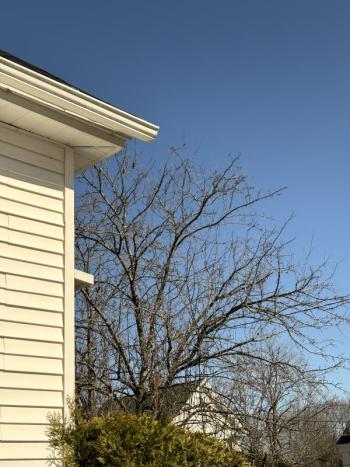 Just as the solar eclipse was reaching its peak, a small flock of bohemian waxwings landed in the authors’ crab apple tree, silhouetted against the dimming blue sky. Courtesy of Allison Wells
Just as the solar eclipse was reaching its peak, a small flock of bohemian waxwings landed in the authors’ crab apple tree, silhouetted against the dimming blue sky. Courtesy of Allison Wells
There is something elemental about a solar eclipse that, for many people, causes an emotional response—a reckoning, perhaps, with the knowledge that we are tiny parts of a vast universe. That a planetary body that shines its face reassuringly on us at night is in constant motion out there circling in space. That the laws of physics means that this same planetary body occasionally finds itself between us and the star that brings us light and warmth.
All of this forces us to grapple with knowledge that normally only astronomers consider. The shadow it casts on the surface of the planet that is our home brings the facts home in a way that discussions and models in the classroom can never do.
We did not travel north to the path of totality, but we were drawn like so many others to experience the eclipse in the way it offered itself in our own backyard. We poked tiny pin holes in cardboard and safely watched the moon slowly turn the circle of the sun into a fingernail crescent.
Of course, we were at the same time watching and listening to the birds on this fine sunny spring day (April 8, 2024, for posterities sake). In the midafternoon warmth, the birds had been lulled. In the distance, a dog was barking but that’s about it.
But then the sun’s strength began to weaken.
As the daylight seemed just slightly to slip into more like the late-day hours and the temperature also dropped slightly but noticeably, the birds became more active again. A flock of goldfinches began to twitter noisily. Cardinals around the neighborhood began belting out their “cheer-cheer-cheer” songs as they normally do in the morning and evening. The local house sparrow gang brought their chirping to a crescendo—a behavior that they often do as they are getting ready for heading off to roost.
And then a surprise: Five bohemian waxwings—the birds we sometimes call the grizzly bear birds because their range overlaps almost completely with the current range of the grizzly bear—landed in our crab apple tree. These birds breed in the Boreal Forest and only come down to our region as unpredictable winter visitors. This afternoon, they looked regal with their maroon undertail feathers; white, yellow and red on the wingtips; black masks, and fine crests, their high-pitched calls rose in intensity—and then they departed.
Right around 3:30 p.m.. the eclipse must have reached the 90% coverage that the astronomers predicted. The light dimmed to dusk-like intensity and the temperature dropped by 15-20 degrees. A flock of rock pigeons zipped through the yard for what they must have thought was the night. Bird songs stopped except for the familiar evening “chup-chup-chup” calls of the robins—the calls they normally give in the last hours of the day before darkness falls.
Our pinhole contraption showed just a tiny sliver of sun showing past the moon.
But this “dusk” lasted only a few minutes. Soon, the blue sky began to brighten. Within about 10 minutes, the cardinals were singing again. The goldfinches resumed their bright and cheerful twittering. A bald eagle came flapping up from a pine tree in the distance where it had presumably and rather suddenly had to make an unplanned stop for the very short “night.”
The eclipse was over here, but the shadow continued to race around the world, giving humans an experience that reminded us all of their place in the universe and the importance of the sun and the moon to all life on earth (birds included).
Jeffrey V. Wells, Ph.D., is a Fellow of the Cornell Lab of Ornithology and Vice President of Boreal Conservation for National Audubon. Dr. Wells is one of the nation's leading bird experts and conservation biologists. He is a coauthor of the seminal “Birds of Maine” book and author of the “Birder’s Conservation Handbook.” His grandfather, the late John Chase, was a columnist for the Boothbay Register for many years. Allison Childs Wells, formerly of the Cornell Lab of Ornithology, is a senior director at the Natural Resources Council of Maine, a nonprofit membership organization working statewide to protect the nature of Maine. Both are widely published natural history writers and are the authors of the popular books, “Maine’s Favorite Birds” (Tilbury House) and “Birds of Aruba, Bonaire, and Curaçao: A Site and Field Guide,” (Cornell University Press).




